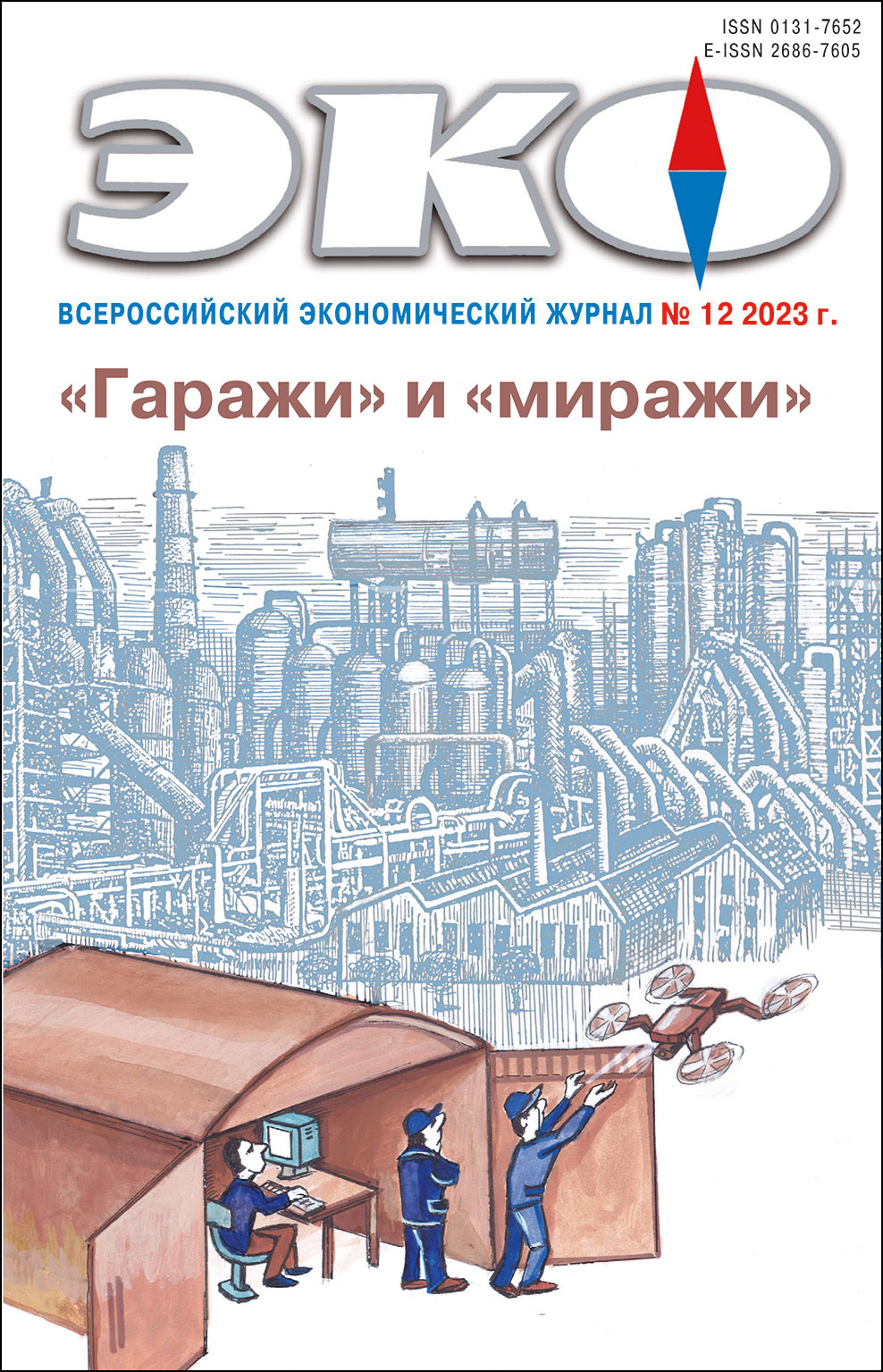ECOLOGY AND ECONOMY
The Effect of Shifting Industrial Activities from the Regional Center to the Periphery on Atmospheric Pollution
Published 2023-11-26
Keywords
- air pollution; Kuznets ecological curve; investments; industry; administrative center; periphery; Moscow; St. Petersburg
How to Cite
1.
Druzhinin П, Moroshkina М, Sedova К. The Effect of Shifting Industrial Activities from the Regional Center to the Periphery on Atmospheric Pollution. ECO [Internet]. 2023 Nov. 26 [cited 2025 Nov. 12];53(12):150-69. Available from: https://ecotrends.ru/index.php/eco/article/view/4694
Abstract
The paper considers the effect of changes in the ratio of industry in the regional center and in the periphery on atmospheric pollution. The dynamics of harmful emissions into the atmosphere for 2000–2021 is analyzed for five regions (Moscow, Leningrad and Arkhangelsk Oblasts, Republics of Karelia and Komi) in the administrative center-periphery section (in the first two cases Moscow and St. Petersburg, which de jure have a special status of subjects of the Federation, were considered). The paper demonstrates the principal factors influencing this dynamics – the removal of industrial enterprises from the center to the periphery, their modernization, and the sectoral structure of industry. Based on the construction of environmental and economic models, the impact of the spatial structure of investments on emissions is shown.References
- Вершинина И.А., Курбанов А.Р., Лядова А.В. Промышленные зоны в современных городах: источник социально-экологического неравенства или возможности для процветания? // Экология и промышленность России. 2018. Т. 22. № 8. С. 65–71. DOI: 10.18412/1816–0395–2018–8–65–71
- Гильмундинов В.М., Тагаева Т.О., Бокслер А.И. Анализ и прогнозирование процессов обращения с отходами в РФ // Проблемы прогнозирования. 2020. № 1 (178). С. 126–134.
- Дружинин П.В. Эколого-экономические процессы в российских регионах в послекризисный период // Друкеровский вестник. 2020. № 1. С. 276–288. DOI: 10.17213/2312–6469–2020–1–276–288
- Дружинин П.В., Шкиперова Г.Т., Поташева О.В., Зимин Д.А. Оценка влияния развития экономики на загрязнение воздушной среды // Экономические и социальные перемены: факты, тенденции, прогноз. 2020. Т. 13. № 2. С. 73–90. DOI: 10.15838/esc.2020.2.73.
- Клевакина Е.А. Экономический рост и качество окружающей среды в приграничных районах КНР в контексте экологической кривой Кузнеца // Записки Забайкальского отделения РГО.2014. № 133–1. С. 88–93.
- Курбацкий А.Н., Шаклеина Е.И. Экономический рост и загрязнение окружающей среды в США и России: сравнительный пространственно-эконометрический анализ // Экономические и социальные перемены: факты, тенденции, прогноз. 2022. Т. 15. № 2. С. 92–107. DOI: 10.15838/esc.2022.2.80.6
- Меркулова Т.А., Григорьева Е.А. Актуальные проблемы экологии в городе Краснодаре // Право. Печать. Вестник КСЭИ. 2018. № 4 (80). С. 68–72.
- Михалищев С.Г., Раскина Ю.В. Экологическая кривая Кузнеца: случай России // Финансы и бизнес. 2016. № 1. С. 17–39.
- Мингалева Ж.А. Опыт промышленного и экологического развития крупнейших городов мира / Экономика и предпринимательство. 2014. № 9 (50). С. 431–433.
- Саблин И.В. Глобализация и окружающая среда: экологическая политика Индии и Китая // Век глобализации. 2014. № 2 (14). С. 105–118.
- Семикашев В.В. Теплоснабжение в России: текущая ситуация и проблемы инвестиционного развития // ЭКО. 2019. № 9. С. 23–47. DOI:10.30680/ECO0131–7652–2019–9–23–47
- Управление отходами в современной России / Под ред. А.В Шевчука. М.: Белый ветер, 2021. 558 с.
- Хан Х.Х., Рахмат С.Р. Исследование динамического воздействия притока ПИИ и экономического роста на состояние окружающей среды: моделирование на основе полностью модифицированного и динамического МНК для отдельных азиатских стран // Вестник международных организаций. 2021. Т. 16. № 3. С. 183–202. DOI: 10.17323/1996–7845–2021–03–08
- Al-Mulali U., Saboori B., Ozturk I. Investigating the Environmental Kuznets Curve Hypothesis in Vietnam // Energy Policy. 2015. Vol. 76. Pp. 123–131. DOI: 10.1016/j.enpol.2014.11.019
- Baek J. A new look at the FDI – income – energy – environment nexus: Dynamic panel data analysis of ASEAN // Energy Policy. 2016. Vol. 91. Pp. 22–27. DOI: 10.1016/j.enpol.2015.12.045
- Copeland B.R., Taylor M.S. North-South Trade and the Environment. The Quarterly Journal of Economics. 1994. Vol. 109. No 3. Pp. 755–787. DOI: 10.2307/2118421
- Grossman G.M., Krueger A.B. Economic growth and the environment. The Quarterly Journal of Economics. 1995. Vol. 110(2). Pp. 353–377.
- He J., Richard P. Environmental Kuznets curve for CO2 in Canada. Ecological Economics. 2010. Vol. 69(5). Pp. 1083–1093. DOI: 10.1016/j.ecolecon.2009.11.030
- Li T., Wang Y., Zhao D. Environmental Kuznets Curve in China: New Evidence From Dynamic Panel Analysis // Energy Policy. 2016. Vol. 91. Pp. 138–147. DOI: 10.1016/j.enpol.2016.01.002
- Liang F.H. Does Foreign Direct Investment Harm the Host Country’s Environment? Evidence from China // Current Topics in Management. 2014. Vol. 17. Pp. 105–121.
- Luukkanen J., Kaivo-oja J., Vehmas J., Panula-Ontto J., Hayha L. Dynamic Sustainability. Sustainability Window Analysis of Chinese Poverty-Environment Nexus Development // Sustainability. 2015. Vol. 7. No.11. Pp. 14488–14500. DOI: 10.3390/su71114488

